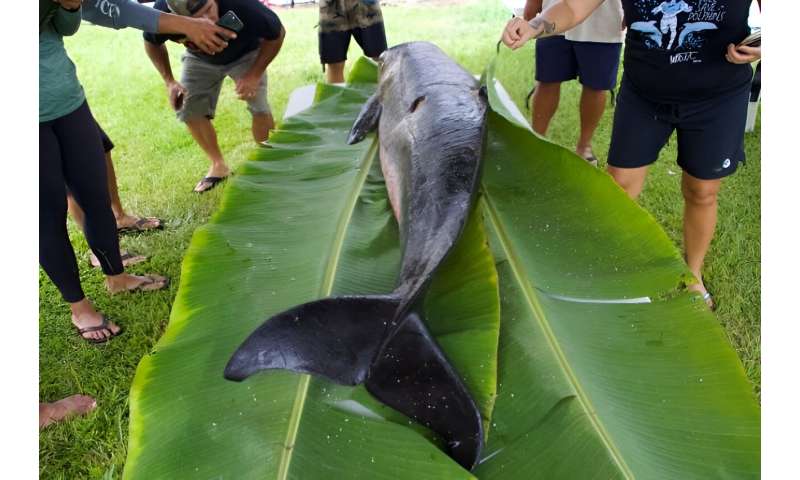Community partners respond to whale, dolphin strandings in Hawaii

Two cetacean strandings on Hawaiʻi Island this summer heralded an important and developing partnership between NOAA Fisheries and the Native Hawaiian Organization Kiaʻi Kanaloa.
Kiaʻi Kanaloa is a multi-island network of Hawaiian cultural practitioners who care for marine animals. We're working with Kiaʻi Kanaloa to develop the Native Hawaiian Organization as a lead responder for cetacean strandings on Hawaiʻi Island.
The partnership is under the umbrella of NOAA Fisheries' Marine Mammal Health and Stranding Program. It builds on long-standing efforts across the state acknowledging the importance of cetaceans in Native Hawaiian culture.
While this partnership is growing, it already has shown great potential during the strandings of a Kogia (pygmy or dwarf sperm whale) calf and a spinner dolphin in July.
Palaoa stranding at Kaʻiliwai
On July 14, 2024, members of the Leleiwi community alerted Kiaʻi Kanaloa that a small palaoa (whale) stranded alive at Kaʻiliwai, a small bay in Hilo. Kiaʻi Kanaloa then contacted us to coordinate a response. Kogia live in deep, offshore water, so finding one nearshore is abnormal.
This Kogia was a calf and had no mother anywhere in sight, which is also not normal. Dolphin and whale calves cannot survive without their mother's care and milk during the early period of their lives. This calf appeared weak and had multiple scratches, likely from scraping against rocks along the shoreline.
When a dolphin or whale strands, the animal is stressed and most likely sick or injured. The most important thing people can do is give it plenty of space and contact trained and authorized responders.
Kiaʻi Kanaloa guided and worked with members of the Leleiwi and Keaukaha communities to respond to this stranding. Hui Hoʻoleimaluō, who are kiaʻi (caretakers) of the area, worked with personnel from the State of Hawai'i Department of Land and Natural Resources and the County of Hawaiʻi Ocean Safety. They ensured the Kogia was given a protected space free of human-caused stressors. The calf passed away naturally soon thereafter.
Kiaʻi Kanaloa and Hui Hoʻoleimaluō members then conducted an external examination. Following NOAA guidelines, they provided us with important scientific information about the stranding. The data will be entered into NOAA's national stranding database so the broader community of stranding responders can learn from patterns of strandings over time.
They also held a discussion with the University of Hawaiʻi Health and Stranding Lab regarding additional post-mortem examination procedures. In consideration of requests expressed by members of the Native Hawaiian community, a necropsy was not performed in this case. Kiaʻi Kanaloa and Hui Hoʻoleimaluō members conducted additional rituals and a burial at sea after collecting the stranding data.
Naiʻa stranding at Laʻaloa Bay
Just a week prior, on July 9, Kiaʻi Kanaloa also led the response and external examination of a nai'a. It had stranded live on the rocks and died soon after at Laʻaloa Bay in Kona. Members of Kiaʻi Kanaloa worked with a University of Hawaiʻi Health and Stranding Lab volunteer to collect blood and a tissue sample. The Lab will use them to screen for diseases of concern in local dolphin populations. Kia'i Kanaloa then gave the dolphin a burial at sea.
Both strandings took the support of many partners, and we are grateful for joint efforts. We look forward to continuing cetacean response training with local kiaʻi. This collaborative effort honors Hawaiian science and Western science, while recognizing the important insights cetaceans provide on the state of our nearshore and deep sea waters.
Provided by NOAA Headquarters